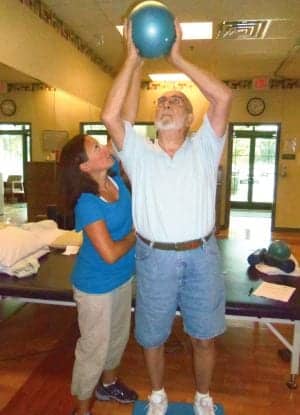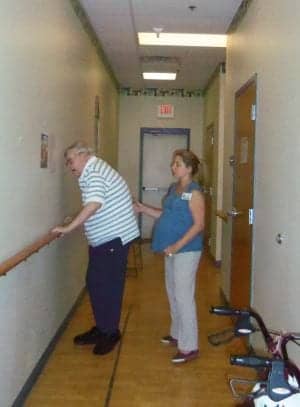
Tricia Butynskyi, PT, DPT, CKTP, site manager at Good Shepherd Rehabilitation Network, Macungie, Pa, works with patient Edwin Wermtan performing exercises on foam to challenge his balance.
As physical therapists, we see patients of all ages and conditions. Each diagnosis presents with its own set of challenges. Most patients have numerous comorbidities that need to be considered when designing a treatment plan. This is especially true of older adults. According to the American Psychological Association, an older adult is someone older than the age of 65 years. Even though many patients fit this description, they are not debilitated. Many are still productive members of their communities, working and staying active.1
What defines debility? The generally accepted definition is the quality or state of being weak, feeble, or infirm, especially physical weakness. As a person ages, they begin to experience progressive degeneration of muscles, which leads to “problems with ambulation, falling and functional dependence.”2 Lower extremity weakness is a key risk factor for falls.2 Many studies support the theory that strength training, cardiovascular exercise, and balance activities can improve the lives of older adults.2-4 Physical therapy intervention and a solid foundation for exercise after discharge from formal therapy will help the elderly patient maintain independence through increased muscle strength, endurance, and confidence.3 This article examines the treatment of the older adult who suffers from debility.
People seek physical therapy services for various reasons: postsurgical, post-injury (such as a motor vehicle accident or fall), post-prolonged hospitalization, chronic conditions, general muscle weakness, gait dysfunction, and deconditioning. Debility can be a primary or tertiary diagnosis for many older patients. For example, many older adults are referred to therapy for musculoskeletal problems, but often are found to have debility as an underlying diagnosis.4 It is the responsibility of allied health professionals to recognize this in clients and address the issue to maximize quality of life. More emphasis must be placed on getting older patients back to their way of life. Simply attaining the range of motion needed to climb stairs reciprocally is not enough. They need to be able to climb the stairs reciprocally without being short of breath.
When evaluating an older adult, the therapist must work to identify the origin of the debility. Patients very often allude to their debility, and often do not recognize it as a problem until they begin performing in therapy. For example, many older patients state their necessary activity level consists of walking from the bed to the bathroom and to the recliner. They often have someone waiting on them, or if they do not, then they do without. It is customary to ask questions that lead the new patient to discuss the previous level of physical exertion. For example, the therapist can ask, “Are you able to walk around the block, to the mailbox, to your garage, car, to the kitchen or bathroom? What do you like to do in your free time? Do you belong to any social clubs or travel?” If the treating therapist is concerned about debility, then assessing the patient’s endurance is necessary to design the plan of care that addresses the primary diagnosis.

Meghan Griech, PT, Good Shepherd Rehabilitation Network, Macungie, Pa, assists patient James Cosgrove in performing both balance and strengthening exercises at a handrail. Here, Cosgrove walks sideways to improve hip adduction strength and challenge his balance.
There are several ways to assess endurance objectively, as it relates to muscle weakness and cardiovascular fitness. The therapist can have the elderly person participate in a simple treadmill walking session or have the patient ride a stationary bike and assess the rate of perceived exertion (RPE) using the Borg Scale.6
Improving a person’s lifestyle from sedentary to somewhat active can increase longevity.7 It is the therapist’s job to educate patients and set them on course to increase their physical activity level. In a study by Meuleman et al, muscle weakness is directly related to increased fall risks2; therefore, it is common to test an older adult’s lower extremity strength via manual muscle testing (MMT). Although it is not the most reliable of tests,5 clinicians are most familiar with MMT and use it. The demonstration of weakness leads to further testing of gait and balance, especially in older adults. Gait and balance are assessed using various tests that include, but are not limited to, the Timed Up and Go (TUG), Tinetti Assessment Tool, Dynamic Gait Index (DGI), and the modified Clinical Test of Sensory Interaction and Balance (mCTSIB). All of these tests have proven reliable, in varying degrees, when assessing gait and fall risk and when used for further vestibular testing.8-11
Debility is often the secondary diagnosis to either a musculoskeletal or neuromuscular problem; therefore, the clinician needs to address both diagnoses with a single, time-efficient plan of care. A paper by Nied and Franklin stated, “Regular exercise provides a myriad of health benefits … and associated with decreased mortality and age-related morbidity in older adults.”12 Up to one-third of the debilitated patients seen in physical therapy can improve with aerobic training.12 With this in mind, it is always a goal to try to develop well-rounded exercise prescriptions for all patients. This is especially true for the older adult, whose goal is to be more active and who does not have the capability or the knowledge to be able to do the desired physical activities in a safe and healthy atmosphere. Whether treating a general debility patient, a postoperative total joint patient, a low back pain patient, or a vestibular patient, most plans of care will include some sort of general conditioning. Nelson et al found an exercise program that consisted of “strength training, balance exercises, and general physical activity improves functional performance and balance in functionally impaired elders.”13
Exercises need to address both the upper and lower body when treating deconditioning and debility to improve overall quality of life.7 A variety of modes should be incorporated to achieve this goal, keeping in mind the primary diagnosis and tailoring the program to the individual. Exercises are performed in a variety of positions to challenge the muscles in different ways. The use of machines, resistance bands, and ankle and free weights is incorporated into the plan of care of the debilitated patient. The machines can include the treadmill, recumbent or stationary bicycle, recumbent stepper, upper cycle, leg press, and the elliptical.
One in three older adults falls each year.17 The combined medical bills for these individuals amounted to about $28.2 billion in 2010, according to the Centers for Disease Control and Prevention.17 Since it has been shown the risk of falls increases with decreased lower extremity strength,18 balance activities are often incorporated into a plan of care. Improving the older adult’s lower extremity strength and conditioning decreases the risk of falls.16 Activities such as standing with perturbation on various surfaces, using therapeutic balls, and walking on various surfaces can address an older adult’s balance deficits and help decrease the risk of falling.
Special consideration needs to be made for the older person with musculoskeletal conditions who is trying to stay active. “Functional decline” and physical limitations are often the result of musculoskeletal conditions.14 It also has been postulated that an older person’s mental health is directly related to the physical independence they enjoy.14 Finding a way to help this population stay active is often difficult because pain is such a limiting factor. One way to combat this is through aquatic therapy.7,18 Exercising in a pool allows the patient to ambulate in a limited weight-bearing atmosphere, while gaining increased resistance from the viscosity of the water.18 Simple water walking can offer a great deal of aerobic exercise, especially in combination with carefully prescribed exercises, such as bicycling and flutter kicks on a noodle, “half jacks” done with the arms only and no jumping, as well as exercises that involve pushing, pulling, and depressing kick boards.
The literature has proven time and again that older adults are capable of performing exercises that will improve both their muscle strength and endurance.15 These individuals are choosing to become more active members in their communities or families, and they want to remain independent. We need to treat elders holistically and help them attain the goals that they are working so hard to achieve.
Tricia K. Butynskyi, PT, DPT, CKTP, currently works as a Site Manager at Good Shepherd Rehabilitation Hospital in Allentown, Pa. Butynskyi has practiced physical therapy for 15 years. Her areas of interest include outpatient management of orthopedic and neuromuscular geriatric patients, vestibular therapy, and aquatic therapy. For more information, contact .
References
- Older Adults’ Health and Age-Related Changes: Reality Versus Myth. Based on What Practitioners Should Know About Working With Older Adults, a publication of the American Psychological Association Working Group on the Older Adult; April 1998.
- Meuleman J, Brechue W, Kubilis P, Lowenthal M. Exercise training in the debilitated aged: strength and functional outcomes. Arch Phys Med Rehabil. 2000;81:312-318.
- Rydwik E, Frandin K, Akner G. Effects of physical training on physical performance in institutionalized elderly patients (70+) with multiple diagnoses. Age Aging. 2004;33:13-23.
- Rubenstein L, Josephson K. Falls and their prevention in elderly people: what does the evidence show? Med Clin North Am. 2006;90:807-824.
- Frese E, Brown M, Norton B. Clinical reliability of manual muscle testing: middle trapezius and gluteus medius muscles. Phys Ther. 1987;67:1072-1076.
- Day M. Monitoring Work Intensities During Resistance Training Using a Session RPE Scale. A Manuscript Style Thesis Presented to the Graduate Faculty of the University of Wisconsin-La Crosse. May 2003:1-41.
- Fletcher G, Balady G, Blair S, et al. Statement on exercise: benefits and recommendations for physical activity programs for all Americans. Circulation. 1996;94:857-862.
- Whitney S, Marchetti G, Schade A, Wrisley D. The sensitivity and specificity of the Timed “Up & Go” and the Dynamic Gait Index for self-reported falls in persons with vestibular disorders. J Vestib Res. 2004;14:397-409.
- Lewis C. Balance, gait test proves simple yet useful. P.T. Bulletin. 1993;2/10:9, 40.
- Whitney S, Hudak M, Marchetti G. The Dynamic Gait Index relates to self-reported fall history in individuals with vestibular dysfunction. J Vestib Res. 2000;10(2):99-105.
- Di Fabio R, Seay R. Use of the “Fast Evaluation of Mobility, Balance, and Fear” in elderly community dwellers: validity and reliability. Phys Ther. 1997;77:904-917.
- Nied R, Franklin B. Promoting and prescribing exercise for the elderly. Am Fam Physician. 2002;65(3):419-426.
- Nelson M, Layne J, Bernstein M, et al. The effects of multidimensional home-based exercise on functional performance in elderly people. J Gerontol A Biol Sci Med Sci. 2004;59(2):154-160.
- Carter S, Rizzo J. Use of outpatient physical therapy services by people with musculoskeletal conditions. Phys Ther. 2007;87:497-512.
- Sullivan D, Wall P, Bariola J, Bopp M, Frost Y. Progressive resistance muscle strength training of hospitalized frail elderly. Am J Phys Med Rehabil. 2001;80:503-509.
- Bird M, Hill K, Ball M, Williams S. Effects of resistance- and flexibility- exercise interventions on balance and related measures in older adults. Journal of Aging and Physical Activity. 2009;17:444-454.
- Centers for Disease Control and Prevention. Falls Among Older Adults: An Overview. February 29, 2012.
- Sova R. Introduction to Aquatic Therapy and Rehab. Port Washington, Wis: DSL, Ltd; 2004.




